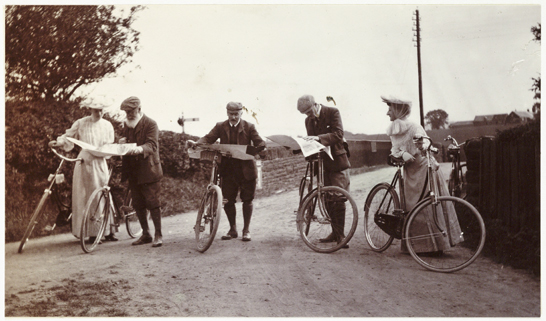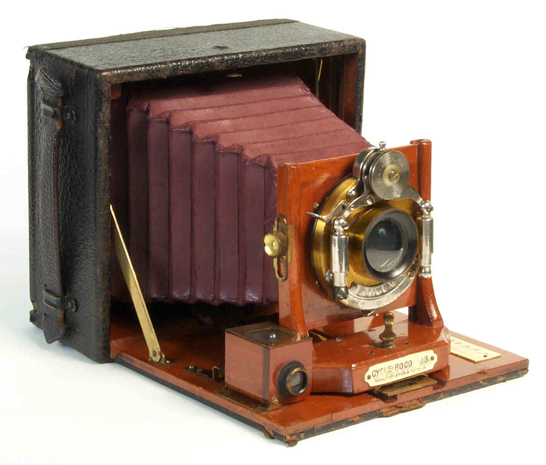Chris Froome’s victory in the Tour de France, combined with the fact that next year the race will be coming to Yorkshire, has caused great excitement locally—even among those whose last experience of cycling involved a pair of stabilisers.
On 5 July 2014, about 200 riders will gather in Leeds for the Grand Départ and the peloton will head off on the 118 mile stage that will finish in Harrogate, passing my house en route.
The event will be a magnet for photographers. I wonder how many of those photographing the spectacle, however, will realise just how closely the history of photography and the history of cycling are interlinked?
Photography’s links with cycling can be traced back to before the medium was invented. Frenchman Nicéphore Niépce is best known as one of the inventors of photography. What is perhaps less well-known is that he is also a key figure in the evolution of the bicycle.
In 1818 Niépce became interested in a precursor of the bicycle called the Laufmaschine (literally, running machine) created by German inventor Karl Drais the previous year. He built himself and improved version with an adjustable saddle which called a velocipédè (fast foot) and caused quite a sensation riding around the country roads near his home in Chalon-sur-Saône. Niépce’s velocipede is now on display in the Niépce Museum.

By the 1860s, velocipedes—popularly known as boneshakers—were an increasingly familiar site on both sides of the Channel. The following account appeared in the Times on 19 February 1869:
On Wednesday Mr. John Mayall, jun., son of the well known photographer, accomplished the journey from London to Brighton on one of the new two-wheel velocipedes. He was accompanied by two friends, Mr. Spencer and Mr. Turner… They kept pretty well together as far as Crawley (30 miles), after which Mr Mayall took a decided lead, and arrived in Brighton in time and in good condition for dinner.
John Mayall was the son of John Jabez Edwin Mayall, who had recently achieved celebrity by taking and publishing the first carte de visite portraits of Queen Victoria and members of the Royal Family.
The photographic press was quick to grasp the potential utility of the velocipede. Just a few weeks after John Mayall’s epic ride, for example, the Illustrated Photographer magazine carried a four page article on Velocipedes for Photographers:
But of all the classes who have adopted this means of progression, photographers appear likely to find it the most useful. The question how most readily to convey the dark tent, water, tripod, camera, etc, with other things required for the wet process, finds a ready reply in the adoption of the velocipede.
By the late 1880s the introduction of the ‘safety’ bicycle and the pneumatic tyre transformed cycling into a leisure activity that could be enjoyed by everyone—including, shockingly to some, women.

The cycling craze of the 1890s coincided with the growth of amateur photography following the introduction of ‘dry’ plates. It was inevitable that the two would come together. As the Photography Annual observed in 1897:
It would be difficult today to find two more popular sources of pleasure, profit or healthy amusement, than has become the separate or combined use of the cycle and camera.

Indeed, that year had seen the launch of a magazine that described itself as ‘The only journal for cycling photographers’—the unimaginatively but accurately titled Cycle and Camera.
To serve this new, expanding market, photographic manufacturers produced camera cases that were design specifically to fit on to bicycle frames or handlebars. Some went even further and branded their cameras with the word ‘cycle’ to reinforce their suitability for touring with a bicycle. In the late 1890s, for example, the Rochester Camera & Supply Co in New York State introduced their Cycle Poco Camera ‘especially designed and intended as a wheeling companion’.

Perhaps we should leave the last word to the Rochester Camera Co’s advertising copywriter:
Health and pleasure are the two most important forces of a well-balanced life. No one can truly realise the magnitude of the world and her varied scenery without the aim of a camera.

A version of this article originally appeared in Black + White Photography magazine in April 2013.
Great article. Thank you.
I was wondering, my Dad is 91 and not a computer user, but that ad for the camera and the bicycle is something he would really enjoy seeing. Is there anyway for me to just print out the ad? Thanks again. (Cycle Poco, 1899)
Hi Cordelia. You should be able to right click on the image and save, then insert into a Word document and print it out for your dad. It won’t be very high resolution, but a good enough copy for him to enjoy. Don’t forget to tell him where it came from!
Great article! Thanks! Now that we know where the cycle in the name came from where did the name Poco come from? Was there a Mr Poco? or was the camera a slow poke ?
I would hazard a guess that the ‘poco’ came either via musical notation (as in ‘poco allegro’, from the established Italian phrase) or perhaps directly from the adjective ‘poco’ in either Italian or Spanish, where it has both an adverbial meaning of ‘rather’ or ‘somewhat’ as in the musical notation above or an adjectival meaning of ‘little’ or ‘small’, and thus provided a perfect description of the (relatively) compact nature of this series of easily transported cameras.